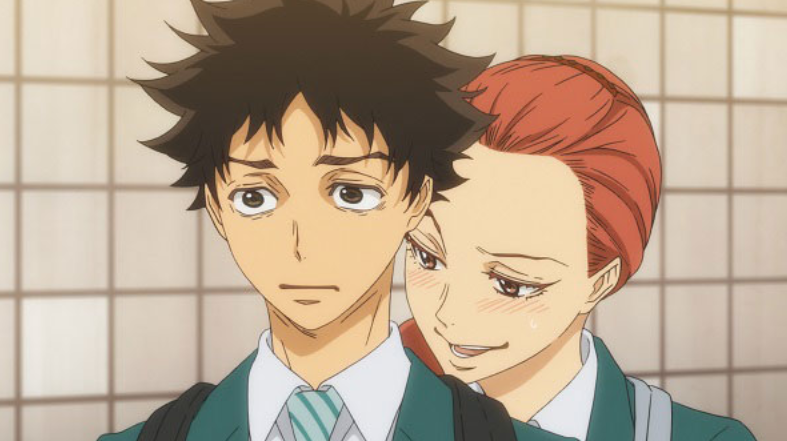Around Akiba proudly presents Welcome to the Ballroom anime review episode 13, “Matchmaking.”
Finally Dancing to a Good Beat
Welcome to the Ballroom has up until this point been a pretty and hollow show, but this week’s episode may have given the series a path to excellence.
It doesn’t start out that way, however. We learn that the mysterious redhead Hiyama Chinatsu (voiced by Akasaki Chinatsu) has cultivated a complicated relationship with ballroom dance, at one point stalking her favorite dancing couple at a competition and at another point chiding Tatara at school for his chosen sport. Chinatsu may be developing too quickly as a character, however. She has manic-pixie tendencies and potentially some queer traits, but these characteristics change too suddenly for the audience to discern what kind of personality she has. She’s no longer mysterious, but rather a mess of details that have yet to be woven together.
Speaking of messy, the story revisits some of its worst tendencies from early in the season. The once portly Banba has lost an entire human’s worth of weight in just a few months, suddenly making her a sex object in a show that doesn’t mind showing skin. Sengoku and his partner Hongo also engage in slapstick humor that should’ve been discarded after episode two. Hyodo’s reappearance into the competitive spotlight marks the episode’s most disappointing fifteen seconds, considering we don’t see anything but a few frames of the show’s most interesting redhead. “Matchmaking” starts shakily, to say the least.
And then everything suddenly clicks in the third act

Chinatsu accepts Tatara’s second invitation to a couple’s practice but soon discovers that Tatara’s inexperience dooms their connection (“I’m not feeling your lead,” she says). So on a whim, Sengoku instructs Tatara and Chinatsu to switch positions, with Chinatsu leading and Tatara following (though a flirty whisper in Chinatsu’s ear suggests he knows something we don’t about her). Tatara gets a quick posture lesson from Hongo, accepts Chinatsu’s lead, and they dance. And it works.
A gender role-reversal that makes as much sense as Chinatsu and Tatara requires an entire season’s worth of setup. We know that Tatara excels not with natural talent, but with an expert ability to replicate other dancers, allowing us to accept Tatara as a follower, not a leader. It’s this sort of trickery that has suddenly given Ballroom a worthwhile cause.
In a sport as needlessly patronizing as ballroom dance, that a show about ballroom dance has decided to challenge its inherent gender roles marks a potentially groundbreaking commentary. Yuri!!! on Ice caused a stir in the figure skating world by normalizing its characters queerness, and Ballroom may embark on something even riskier. By questioning the construct of men as leaders and women as followers, Ballroom might just criticize the entire foundation of ballroom dance, a sport it reveres through its caring and excellent animation.
Of course, the show might also revert to the heteronormative storyline it followed in the first half of the season (no spoilers please, manga readers), and they can hardly be blamed if they do. Having Chinatsu lead and Tatara follow represents a high-risk, high-reward scenario, and Ballroom hasn’t taken many risks up to this point. But if they pull it off, those Yuri comparisons whispered about before the first episode might start to get traction.